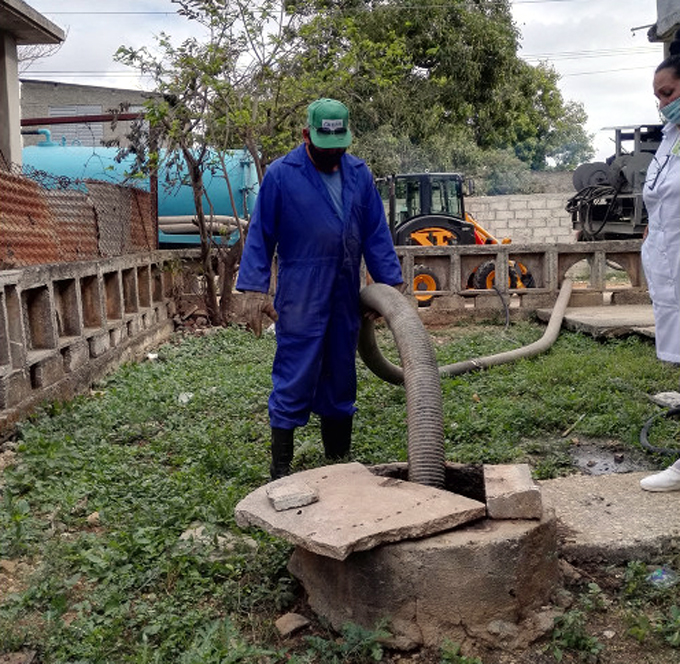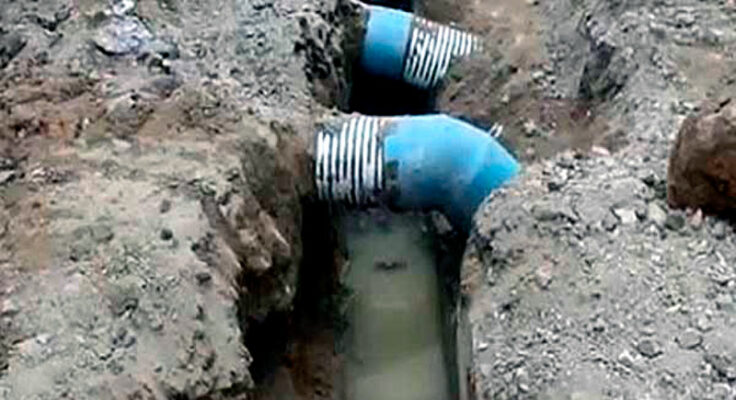
As soon as dawn breaks, Martha gets up to prepare breakfast and instinctively places a large basin under her sink. She adopted this routine more than six months ago. When the pit in her house is about to empty, she removes the drain connection, collects the waste, and then throws it into "the less-traveled part of her street, so as not to be so inconsiderate," she says.
During the dialogue, she places the container between her face and the recorder on more than one occasion. She assures that this is the reason why she has a sharp pain in her back, which often keeps her awake at night.
"You can't imagine how many bowls I have to throw away, that's why I can't go that far."
Martha's family has a pit of just a few cubic meters that usually fills up in a little less than a month. A few years ago, these neighbors of the Fernando Betancourt neighborhood were not burdened with such a problem, because they would make the report and in one or two weeks the dump truck would go and do its job for only 10.00 pesos. But since at the beginning of 2021 the service raised its cost to 280.00, the numbers no longer add up so easily in the monthly budget.
"We are paying for it two or three times a year, we can't afford more, because I am retired and our income is barely enough to eat," confesses the 60-year-old. Sometimes we have it overflowing and there is no one to live with because of the bad smell and the flies. We have to dig ditches, pour oil, and pray that it doesn't rain."
Other inhabitants in Las Tunas share similar realities, especially in a province where 40 thousand pits are still active and, according to experts, less than 20 percent of the places have sewage systems.
DISCOLORATIONS OF DAILY LIFE
The increase in the price of this service by the Water and Sewage Company, in line with the process of economic reorganization that the country has undergone, has conditioned a new problem that today is making its negative impact felt in different communities.
 There has been a drop in reports," says Alcides Naranjo, director of Maintenance and Investments of the entity in Las Tunas. In 2021, the total number of requests was only 33 percent of those received the previous year. We had 6,294 requests and only 35 pits were pending. On the other hand, at the end of 2020, we could not attend more than 300 and in 2019 the number was more than 2,000. Many times we had between 500 and 600 pourings, and the panorama was more complicated.
There has been a drop in reports," says Alcides Naranjo, director of Maintenance and Investments of the entity in Las Tunas. In 2021, the total number of requests was only 33 percent of those received the previous year. We had 6,294 requests and only 35 pits were pending. On the other hand, at the end of 2020, we could not attend more than 300 and in 2019 the number was more than 2,000. Many times we had between 500 and 600 pourings, and the panorama was more complicated.
"In the current scenario, fundamental issues have had an impact -emphasizes the manager-, there was an increase in the rate, it seems high to people and they have not yet assumed it as a mandatory expense for household hygiene."
"It is true that some families, because of the higher amount, act more responsibly and take care not to waste water and encourage early filling, but this is not always the case. In many opportunities, we have observed that, as a result of this situation, there are settlers who divert the sinks to the street and pour liquids, waste from corrals, and other waste that conspire against health."
Kiuris Álvarez Batista, director of the Environmental Sanitation base business unit of the head municipality, emphasizes that - unfortunately - in various tours, they have verified that pits are dumping without their owners making the report. When inspectors visit them, they claim that they do not have the resources to pay.
"Currently, the locality has 330 approved pits, which are filled in about 15 days. Faced with this fact we implemented a strategy, the service is charged, but we divide it between the number of annual cleanings to collaborate with the family economy. We give priority attention to these cases."
"There are parts of the city with very specific issues. In La Loma, 65th Street is one of the areas with the most dumping; La Victoria also has a high incidence. There, many residents do not make the reports and everywhere there are plenty of examples of four or five houses connected to a four cubic meter pit."
The experts point out that one of the main causes of this phenomenon is the number of reservoirs of this type built by the population without complying with the technical requirements and the necessary water tightness, which is why they fill up easily when it rains. They also warn that by connecting them with pig pens, the traditional cleaning cycles, which should be once or twice a year, are shortened.
IMMEDIATE CHALLENGES
The issue has an important impact on the daily life of this region. A pit that leaks and is not reported can complicate the epidemiological situation of entire communities and this is by no means a minor issue.
The director of Maintenance and Investments of the company in the territory explains that at present they attach importance to the construction of simplified sewers, as a strategy to eliminate the most difficult areas. In the previous calendar, a similar project was executed in the municipality of Manatí, with very favorable results. To date, a similar project is being planned for Camilo Cienfuegos Street in the capital city.
Dumping in Las Tunas can be reported through the EnZona platform. Today, more than 80 requests are being dealt with through this channel within 72 hours, according to specialists.
The province has sewage cars in all the municipalities, except in Colombia, and experts confirm that it is enough to meet the current demands. Water and Sewage Company, for its part, continues to give priority to reiterative cases, as well as to control that the increase in prices is not an excuse for indiscipline and a sanitary incident occurs.





